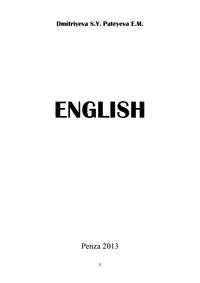Buch lesen: "Английский язык"
Предисловие
Данное пособие предназначено для занятий со студентами инженерных факультетов сельскохозяйственных вузов. Целью пособия является формирование у студентов навыков работы с профессионально-ориентированными текстами, расширение терминологического словаря и развитие умений и навыков общения в рамках своей будущей профессии.
Источником послужили как оригинальная литература, так и учебные тексты российских авторов. Тематика выбранных текстов охватывает сферы науки, техники, страноведения и сельского хозяйства. Не являясь базовым учебником для студентов младших курсов инженерного факультета, пособие может стать удачным дополнением к основному курсу, разнообразить языковое общение преподавателя и студентов на занятиях по английскому языку.
Пособие состоит из трех основных циклов, выделенных по тематическому признаку и одного дополнительного цикла. В конце сборника дан словарь основных технических терминов.
Тексты каждого цикла даны в логической последовательности: от общего представления отрасли до конкретных машин и оборудования. Материалы последнего цикла нацеливают на общение и носят выраженную коммуникативную направленность.
UNIT I
ENGINEERING

Text 1
Engineering Thinking
Engineering is putting knowledge of Nature to practical use. The final product of engineering is some physical thing: a machine, a tool, a garget. Engineering is solving problems. It is convenient to discuss engineering projects within the framework of five steps for solving problems
• Will you restore the logical order of these steps?
A good engineer first … second … next … then … and last …
a) defines the problem; b) verifies the solution; c) identifies possible solutions; d) implements the solution; e) selects a solution..
• Can you prove the following ideas? Will you say a few words in favour of each?
– It is important for an engineer to have a creative mind and to generate new ideas.
– It is obligatory to consult the scientific literature available on the problem under study.
– It is not recommended to trust the intuition.
– It is desirable for an engineer to enjoy the whole life cycle of the product designed by him.
– It is useful to have a feedback between an engineer and a customer.
Wordlist
engineering – инженерное дело, техника
final product – конечный продукт
tool – инструмент
to solve a problem – решить проблему
framework – основа
creative mind – творческий ум
obligatory – обязательные
desirable – желательный, заданный
feedback – обратная связь
Answer the questions.
1. What is engineering?
2. What is the final product?
3. Is it important to consult scientific literature?
4. Do you trust your intuition?
Text 2
Machines
In his activities man makes use of a multitude of machines. Although most of them are of quite recent origin, a few simple ones are considered to have come from very ancient times. There were a lot of prehistoric implements, the bow and the arrow being the most ancient. They were his tools in his struggle for existence.
The wheel, one of the greatest inventions ever made by man is also of prehistoric origin. The inclined plane and its use have also been known. It was doubtless by its use that Egyptian slaves lifted the huge stones that went into the construction of the great pyramids.
The lever is probably of equally ancient origin. It is mentioned by the Greek Philosopher Aristotle as a means of lifting a great weight by using a very small force.
Tremendous changes in machine development were made in the 20th century. Now we use not only powerful devices, precise instruments, but also ―clever machines.‖
Wordlist
activity – деятельность
multitude – множество, огромное количество
bow and arrow – лук и стрела
to be of recent origin – быть недавнего происхождения
implement – орудие, приспособление
wheel – колесо
inclined plane – наклонная плоскость
slave – раб lever – рычаг
powerful device – мощное устройство
Answer the questions.
1. What implements have come from ancient times?
2. What role did the inclined plane play?
3. What can you say about machine development in the 20th century?
4. What "clever machines" do you know?
5. What were these machines used for?

Text 3
The internal combustion engine
The internal combustion engine is an engine in which the combustion of a fuel (normally a fossil fuel) occurs with an oxidizer (usually air) in a combustion chamber that is an integral part of the working fluid flow circuit. In an internal combustion engine (ICE) the expansion of the high-temperature and high-pressure gases produced by combustion apply direct force to some component of the engine. The force is applied typically to pistons, turbine blades, or a nozzle. This force moves the component over a distance, transforming chemical energy into useful mechanical energy. The first commercially successful internal combustion engine was created by Étienne Lenoir

The cycle is characterized by four strokes, or straight movements alternately, back and forth, of a piston inside a cylinder:
1. intake (induction) stroke
2. compression stroke
3. power (combustion) stroke
4. exhaust stroke
1) The cycle begins at top dead center, when the piston is at its uppermost point. On the first downward stroke (intake) of the piston, a mixture of fuel and air is drawn into the cylinder through the intake (inlet) port.
2) The intake (inlet) valve (or valves) then close(s), and the following upward stroke (compression) compresses the fuel-air mixture.
3) The air-fuel mixture is then ignited, usually by a spark plug for a gasoline or by the heat and pressure of compression for a Diesel cycle of compression ignition engine, at approximately the top of the compression stroke.
4) The resulting expansion of burning gases then forces the piston downward for the third stroke (power), and the fourth and final upward stroke (exhaust) evacuates the spent exhaust gases from the cylinder past the then-open exhaust valve or valves, through the exhaust port.
Wordlist
internal combustion engine – двигатель внутреннего сгорания
fuel – топливо
to occur – происходить
chamber – камера
piston – поршень
nozzle – форсунка, наконечник, выпускное отверстие
stroke – ход, такт
intake – всасывание compression – сжатие
to ignite – воспламенять(ся) зажигать
Die kostenlose Leseprobe ist beendet.

